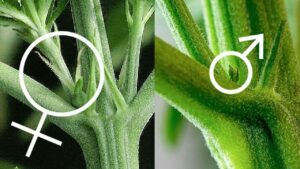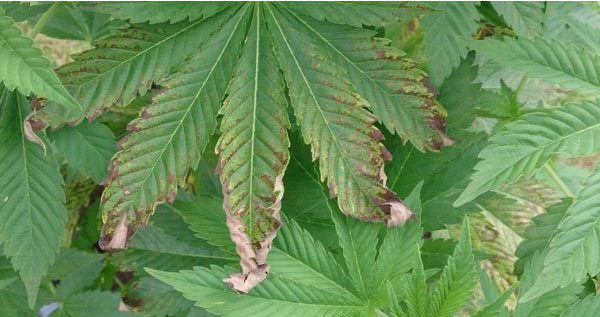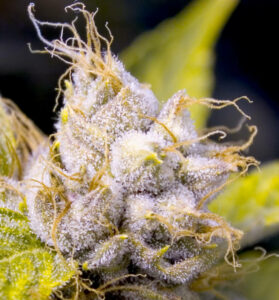The marijuana flowering stage comes right after the vegetative stage. It is the final stage of your plant’s life and arguably, the most exciting. In just a few weeks you’ll get to enjoy the fruits of your labor in the best way possible. However, contrary to the vegetative stage, marijuana plants tend to be much less forgiving during flowering.
During the flowering stage, the room for errors decreases dramatically, and it is important that you know what to expect. Knowledge is power, and, in this case, can save you a lot of time and a significant investment. So, let’s try to understand how cannabis grows during the flowering stage.
Entering the Marijuana Flowering Stage
Unless you are growing an autoflowering variety, your plants will never enter the flowering period unless you switch their light cycle to an equal cycle of light and darkness (12/12). Some growers go as far as keeping their plants completely in the dark. When the plant realizes that the days have gotten shorter, it will think winter is coming, and hence, that it is time to flower.
Outdoors, this process will start automatically, as long as the plant has not been exposed to extreme environments. If you plant the seed in early spring, your plant will grow through summer and will flower in the fall (when exactly depends on the strain). Both indoors and outdoors, the flowering phase is triggered as the light gets scarcer. And this is where the fun begins!
Identifying Sex During Early Flowering
When you change the light schedule of your plants, it is important to make sure that absolutely no light enters the grow room when growing indoors. The slightest disruption might mess up your plants’ development and lead to hermaphroditism, or even worse, no buds!
During the first few weeks of flowering, your plant will grow vigorously and might actually double in size very quickly. So, if you haven’t trained your plant, make sure that you have some overhead to avoid the canopy touching the grow lights. Also, this around the time that you should start checking the sex of your plants.

The difference between male and female organs should be really easy to spot!
We might have said that before, but in cannabis growing males are absolutely useless. They don’t grow bud and their pollen sacks can destroy your whole crop if they burst and pollinate nearby females. So, don’t neglect what grows under the foliage!
Female plants will start growing pistils, while males will grow easily identifiable pollen sacks. You should remove these plants without mercy!
- Pistils look like elongated tiny, hair-like leaves
- Pollen sacks look like balls (well, they are balls)
- It is perfectly possible for your plant to grow both. That is the sign of hermaphroditism. If you notice something like that, remove the plant immediately.
Weeks 1-3: The Early Flowering Stage
The “stretch phase” is something you should be prepared for, as some plants can potentially double in height. So, if you haven’t already, there is still time to train your plants! Try some LST methods to avoid hurting it at this delicate stage but make sure that your canopy should not touch the grow lights under any circumstances.
During the first three weeks, it is unlikely that you will see any buds growing on your female plants. However, pistils should be visible in the spots between the bigger leaves and the main stem. If instead of pistils you see pollen sacks, remove the plants ASAP (see the previous section).
Week Four: I’m Starting to See Something!
During the third week of flowering, you’ll start noticing that the growing frenzy of your plant has significantly slowed down. This is also when your plants will start producing small buds. However, we’re still a long way to go before they’re ready for consumption.
As the plant races through the flowering phase, it focuses all of its energy towards producing buds. Therefore, it is normal to see some discolored leaves near the bottom of the plant and in under-lit spots. Of course, that doesn’t mean that you shouldn’t be alarmed if your plant starts losing out leaves rapidly. At this point, you should be very quick to diagnose and remedy deficiencies, as recovery is much harder at this sensitive phase.
Talking about deficiencies, did you know you that too many nutrients can burn your plant? Well, not literally burn it, but they can cause leaves to yellow, wilt and fall. So, go easy on the nutrients and choose organic solutions if you can.
During weeks 4-8 (approximately) your buds will start fattening and ripening, while plant growth will come to a halt altogether. Measure the pH and temperature of your grow room to avoid bud problems such as “foxtailing” (when a bud grows out of the side of an old bud that’s already developed). Do not attempt to touch or train the plant unless it touches the grow lights. In such a case, you can try to gently tie it down.
Late Marijuana Flowering Stage
About 6-8 weeks into harvesting, you should be getting really close to a harvest. You’ll notice by all the buds covering the kolas and the overpowering stench of cannabis stinking everything around and inside the growing area. Your job during this phase is to ensure that things go seamlessly until harvest and watch out for any deficiencies or major discolorations.

Not all plants grow at the same rates, but you will know your plant is ready for harvesting by looking at the trichomes and the pistils with a magnifying glass. During the last few weeks of flowering, it is recommended that you stop giving your plants nutrients and just water them with distilled water. This will clear up any chemicals building up in the buds and give you a higher-quality product.
As a rule of thumb, marijuana strains are ready for harvest at different points:
- Indica: ready after 6-8 weeks of flowering
- Sativa: harvest after 8-10 weeks of flowering
- Autoflowering: 10 weeks from seedling to bud
However, most of the seeds currently on the market are hybrids. Read more about the genetic line of the strain you are growing to get a clearer idea of its particular timeline.
When is the Right Time to Harvest?
The transition from flowering to harvest is tricky, as there is no standard timestamp for it. You’ll need to watch out for signs, such as:
- The resin on the buds will start to gradually get brown
- The pistils will start turning red
- The main kola will start expanding.
These are some of the most glaring signs that your plant is approaching harvest time. Exactly when you’ll harvest though, depends on your personal preferences. A magnifying glass will come in handy at this point because the trichomes on the cannabis buds and the pistils are your best bet to a successful harvest.

This is a kush flower ready for harvest! Tasty, right?
If the pistils are equally white/brown, then your cannabis is still young. Wait until the pistils are mostly brown before you harvest. Same goes for trichomes: If they are clear, then your flowers are not ready. Wait until half of them are milky white and half amber for the best effects. If you wait too long, your marijuana will be very heavy and most THC will break down to CBD.

Leave a Reply